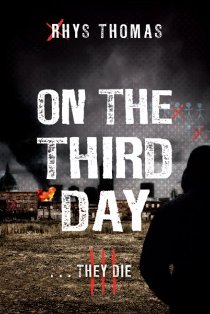
First published in July of 2010, Welsh author Rhys Thomas (hailing from the glamorous location of Pontyclun no less) delves head first into the post-apocalyptic subgenre with his second novel ‘On The Third Day’; cashing in on the recent renewal of interest in this bleak situational concept. Indeed, the book’s cover blurb markets the novel as “28 Days Later meets The Survivors “(sic). In many aspects of the novel this comparison is a reasonably good representation of what’s on offer here. However, for the more post-apocalyptic savvy amongst us, you can throw in much closer comparisons to novels such as ‘Among Madmen’ (1990), ‘Blood Crazy’ (1995) ‘Hater’ (2006), ‘Cell’ (2006) and dare I say early elements of ‘The Passage’ (2010)? Throw in the heavy emotional end-of-days turmoil of ‘The Road’ (2006), ‘Earth Abides’ (1949), ‘The Rift’ (1998) or indeed ‘On The Beach’ (1957) – and you pretty much hit the nail on the head.
DLS Synopsis:
All of a sudden the world is unceremoniously brought to its knees by an inexplicable illness dubbed ‘The Sadness’, that once contracted, drags the infected into bottomless depths of despair. And as the symptoms persist, it pushes them to unprovoked acts of mindless violence, until after the third day, they succumb to death. Amongst the havoc, panic and chaos that this spreading illness is causing, Miriam Asher, together with her stepbrother, Joseph, attempt to protect Asher’s young son and daughter, after her husband is taken by The Sadness. And it is a bitter struggle to survive amongst this violent and savagely uncaring new world.
After travelling to the rural and somewhat isolated location of Joseph’s seaside cottage, the family attempt to start off a simple self-reliant life for themselves, away from all the unpredictable madness that has consumed the world.
However, when a huge ship crashes into the coastal shores which their cottage overlooks, a flood of survivors take to the beach; onto which the beginnings of a new community quickly starts to form. But not everyone left unaffected by The Sadness is so peace-loving. Clad in black, with gas marks obscuring their features, an army of merciless killers are scoring the land, destroying crops, plundering shops and brutally murdering everyone they cross. Once again, the world looks bleak for every last survivor. Their individual judgements are at hand...
DLS Review:
From the very outset of the novel, Thomas leans heavily towards the downbeat emotional conflict and destructive strain that is put on each one of the lead individuals, setting down an altogether bleak atmosphere for the story to draw a path through. The result is a powerfully character driven storyline, that carefully treads through a complex array of emotional levels that are vividly portrayed by this handful of principal characters.
Although Miriam and her family are the constant-thread that the storyline is based around, a number of other often hazy subplots and parallel running storylines are interwoven around their story, creating a complex tale that flutters between a multitude of miniature sub stories and vague glimpses of ‘something else’.
The surreal and dreamlike quality of Thomas’ writing style creates a perfect breeding-ground for an atmospherically apocalyptic setting, with ideas of biblical retribution bounded around here and there, as well as much vaguer open-ended sequences, set down to allow the imagination of the reader to embark on their own individual paths.
The tale haphazardly builds towards a handful of dramatic finales, each one clumsily set amongst the overall dominating direction of the story - that of the ever-increasing threat of the marauders in black. To this aspect of the storyline, The Sadness takes a sudden (and quite unexpected) backseat.
The tone of the novel is set at a constantly depressive low; with moments of relief and joy few and far between amongst the overwhelming misery that is portrayed. The unavoidable bleakness quickly becomes claustrophobic and utterly oppressive, which is maintained and drawn upon throughout the length of the tale.
Thomas often wanders off the path of his story, choosing to spend a number of pages on characteristically insightful dream-sequences, emotionally driven thoughts and mysterious glimpses of a possible answer to the background question of ‘why?’.
All in all, the novel is a triumph of bleak and depressive post-apocalyptic fiction. The story is well written, with skilfully developed characterisation as well as a powerful and gripping plot. However, the structure to the tale often becomes too loose, with meandering subplots that ultimately leave the reader feeling outside of the storyline and potentially losing interest.
Although the suggestive glimpses of ‘something more’ are intriguing and encourage the reader’s imagination to run loose on the possibilities, the overuse of this ploy has instead resulted in a slightly unsatisfying conclusion to the tale. This however does not overshadow the powerfully emotional strength of the tale, or indeed its masterfully delivered post-apocalyptic atmosphere.
The novel runs for a total of 520 pages.
© DLS Reviews






